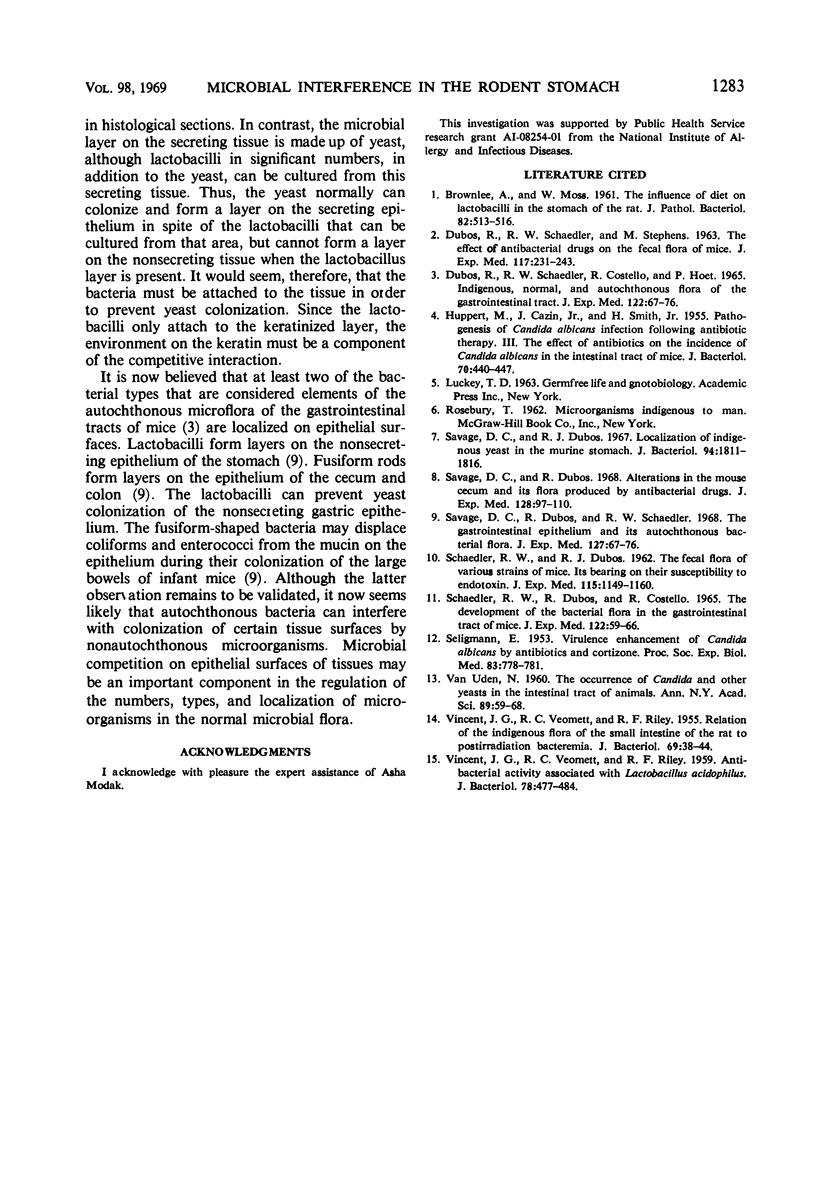Abstract
Indigenous yeasts grow in layers in the mucus on the secreting epithelium of the stomachs of some strains of rats and mice raised under conventional conditions. Likewise, indigenous lactobacilli appear in layers on the nonsecreting epithelium of the stomachs of rats and mice. The two microbial layers can coexist in the same animals. When I gave such rodents penicillin solution in the place of drinking water, the lactobacilli disappeared, and the yeast from the secreting epithelium colonized the nonsecreting epithelium within 24 hr. The yeast remained in layers on the nonsecreting, as well as the secreting epithelium, as long as penicillin was administered. There is no inflammatory reaction or any sign that the yeast invaded below the keratin layer. When the penicillin treatment was discontinued, within 5 to 8 days the indigenous lactobacilli again colonized the nonsecreting epithelium. Concomitantly the yeast was displaced from the keratinized tissue and once more could be found only on the secreting epithelium. Only 2 days were required, however, for the bacteria to recolonize the keratin layer and displace the yeast when the mice were given indigenous lactobacilli in pure culture immediately after the penicillin treatment was discontinued. The lactobacilli must displace the yeast from the nonsecreting epithelium by interfering either with multiplication of the yeast on the tissue or with attachment of the yeast cells to the keratin layer. This interference must proceed continuously during normal life since the yeast never populates the nonsecreting epithelium as long as the lactobacilli are present.
Full text
PDF





Images in this article
Selected References
These references are in PubMed. This may not be the complete list of references from this article.
- BROWNLEE A., MOSS W. The influence of diet on lactobacilli in the stomach of the rat. J Pathol Bacteriol. 1961 Oct;82:513–516. doi: 10.1002/path.1700820227. [DOI] [PubMed] [Google Scholar]
- DUBOS R., SCHAEDLER R. W., COSTELLO R., HOET P. INDIGENOUS, NORMAL, AND AUTOCHTHONOUS FLORA OF THE GASTROINTESTINAL TRACT. J Exp Med. 1965 Jul 1;122:67–76. doi: 10.1084/jem.122.1.67. [DOI] [PMC free article] [PubMed] [Google Scholar]
- HUPPERT M., CAZIN J., Jr, SMITH H., Jr Pathogenesis of Candida albicans infection following antibiotic therapy. III. The effect of antibiotics on the incidence of Candida albicans in the intestinal tract of mice. J Bacteriol. 1955 Oct;70(4):440–447. doi: 10.1128/jb.70.4.440-447.1955. [DOI] [PMC free article] [PubMed] [Google Scholar]
- SCHAEDLER R. W., DUBOS R. J. The fecal flora of various strains of mice. Its bearing on their susceptibility to endotoxin. J Exp Med. 1962 Jun 1;115:1149–1160. doi: 10.1084/jem.115.6.1149. [DOI] [PMC free article] [PubMed] [Google Scholar]
- SCHAEDLER R. W., DUBOS R., COSTELLO R. THE DEVELOPMENT OF THE BACTERIAL FLORA IN THE GASTROINTESTINAL TRACT OF MICE. J Exp Med. 1965 Jul 1;122:59–66. doi: 10.1084/jem.122.1.59. [DOI] [PMC free article] [PubMed] [Google Scholar]
- SELIGMANN E. Virulence enhancement of Candida albicans by antibiotics and cortisone. Proc Soc Exp Biol Med. 1953 Aug-Sep;83(4):778–781. doi: 10.3181/00379727-83-20488. [DOI] [PubMed] [Google Scholar]
- Savage D. C., Dubos R. J. Localization of indigenous yeast in the murine stomach. J Bacteriol. 1967 Dec;94(6):1811–1816. doi: 10.1128/jb.94.6.1811-1816.1967. [DOI] [PMC free article] [PubMed] [Google Scholar]
- Savage D. C., Dubos R. Alterations in the mouse cecum and its flora produced by antibacterial drugs. J Exp Med. 1968 Jul 1;128(1):97–110. doi: 10.1084/jem.128.1.97. [DOI] [PMC free article] [PubMed] [Google Scholar]
- Savage D. C., Dubos R., Schaedler R. W. The gastrointestinal epithelium and its autochthonous bacterial flora. J Exp Med. 1968 Jan 1;127(1):67–76. doi: 10.1084/jem.127.1.67. [DOI] [PMC free article] [PubMed] [Google Scholar]
- VAN UDEN N. The occurrence of Candida and other yeasts in the intestinal tracts of animals. Ann N Y Acad Sci. 1960 Aug 27;89:59–68. doi: 10.1111/j.1749-6632.1960.tb20130.x. [DOI] [PubMed] [Google Scholar]
- VINCENT J. G., VEOMETT R. C., RILEY R. F. Antibacterial activity associated with Lactobacillus acidophilus. J Bacteriol. 1959 Oct;78:477–484. doi: 10.1128/jb.78.4.477-484.1959. [DOI] [PMC free article] [PubMed] [Google Scholar]
- VINCENT J. G., VEOMETT R. C., RILEY R. F. Relation of the indigenous flora of the small intestine of the rat to post-irradiation bacteremia. J Bacteriol. 1955 Jan;69(1):38–44. doi: 10.1128/jb.69.1.38-44.1955. [DOI] [PMC free article] [PubMed] [Google Scholar]



